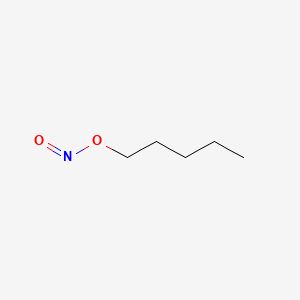



1. Nitrite, Amyl
1. Pentyl Nitrite
2. 463-04-7
3. N-amyl Nitrite
4. N-pentyl Nitrite
5. Nitrous Acid, Pentyl Ester
6. Pentyl Alcohol, Nitrite
7. Nitrous Acid Pentyl Ester
8. H2hux79fyk
9. Chebi:55344
10. Pentylnitrite
11. Ccris 763
12. Einecs 207-332-7
13. Unii-h2hux79fyk
14. Brn 1701241
15. N-pentylnitrite
16. Ai3-25184
17. Amyl 1 Nitrite
18. 1-pentyl Nitrite
19. N-phenyl Nitrile
20. Nitrite De Pentyle
21. Dsstox_cid_4522
22. Un 1113 (related)
23. Pentyl Nitrite, Aldrichcpr
24. Dsstox_rid_77442
25. Dsstox_gsid_24522
26. Schembl34065
27. 4-01-00-01644 (beilstein Handbook Reference)
28. Chembl3188202
29. Dtxsid3024522
30. Hsdb 8468
31. Amy3989
32. Tox21_202898
33. Mfcd00036132
34. Stl268844
35. Zinc20230701
36. Akos015853631
37. Db01612
38. Ncgc00260444-01
39. Cas-463-04-7
40. Ls-13085
41. A0455
42. Ft-0622367
43. A19477
44. D88264
45. A802198
46. Q412350
| Molecular Weight | 117.15 g/mol |
|---|---|
| Molecular Formula | C5H11NO2 |
| XLogP3 | 1.8 |
| Hydrogen Bond Donor Count | 0 |
| Hydrogen Bond Acceptor Count | 3 |
| Rotatable Bond Count | 4 |
| Exact Mass | 117.078978594 g/mol |
| Monoisotopic Mass | 117.078978594 g/mol |
| Topological Polar Surface Area | 38.7 Ų |
| Heavy Atom Count | 8 |
| Formal Charge | 0 |
| Complexity | 56.4 |
| Isotope Atom Count | 0 |
| Defined Atom Stereocenter Count | 0 |
| Undefined Atom Stereocenter Count | 0 |
| Defined Bond Stereocenter Count | 0 |
| Undefined Bond Stereocenter Count | 0 |
| Covalently Bonded Unit Count | 1 |
/EXPL THER/ Presented is a case of idiopathic priapism that was successfully treated with inhalation of amyl nitrite. Routine treatment measures had failed. The same patient presented on several other occasions in a similar fashion. Each time amyl nitrite was successful. An investigation for diseases known to be associated with priapism proved negative. Due to the frequency of recurrences, definitive surgical management was offered. The patient refused and has been lost to follow up.
PMID:6132570 Parrillo SJ, Manfrey S; Ann Emerg Med 12 (4): 226-7 (1983)
/EXPL THER/ Acute catastrophic pulmonary vasoconstriction frequently leads to cardiovascular collapse. Rapid and selective pulmonary vasodilation is desired in order to restore hemodynamic stability. This pilot study examined the effectiveness of inhaled amyl nitrite as a selective pulmonary vasodilator. Nine adult swine were anesthetized. Acute pulmonary hypertension with hemodynamic collapse was induced with a bolus administration of a thromboxane analogue, U46619. Six animals then received a capsule of amyl nitrite. The administration of inhaled amyl nitrite decreased mean pulmonary artery pressure from 42 +/- 3 to 22 +/ 3 mm Hg at five minutes (p < 0.05), with a concomitant increase in cardiac output and mean arterial pressure. Pulmonary vascular resistance decreased from 4889 +/- 1338 to 380 +/- 195 dyne. sec. cm(-5) (by 92% from the maximal pulmonary hypertension change), with significant improvement in systemic hemodynamics. During acute thromboxane-mediated pulmonary hypertension with cardiovascular collapse, prompt administration of inhaled amyl nitrite was effective in restoring pulmonary and systemic hemodynamics within five minutes.
PMID:17644883 Muehlschlegel JD et al; Ann Card Anaesth 10 (2): 113-20 (2007)
/EXPL THER/ Amyl nitrite is a smooth muscle relaxant that has been used clinically to facilitate uterine relaxation in difficult deliveries. In this retrospective study, we evaluate the safety of amyl nitrite use during preterm cesarean deliveries, and we assess possible advantageous effects on surgical incision choice. Women who received amyl nitrite cesarean section were compared to a control group matched for gestational age, fetal presentation, and mode of delivery who did not receive amyl nitrite. There were no statistical differences between the groups in the independent variables (maternal age, parity, medical or obstetric history, type of anesthesia, anesthesia or obstetric attending physician, antepartum hematocrit, or neonatal weight). Outcome (dependent) variables (estimated blood loss, Apgar scores, postpartum hematocrit, cord gases, or postpartum complications) were assessed, and there were no significant differences between the groups. Low transverse cesarean section was performed more frequently in the amyl nitrite group (58 of 64) than in the comparison group (48 of 64) (p less than 0.03). Considering the 128 women with and without amyl nitrite together, the decrease in hematocrit observed postpartum was greater after classic section (7%) than after low transverse section (4%) (p less than 0.002). We conclude that the use of amyl nitrite during preterm cesarean section poses no threat to mother or fetus and may facilitate delivery by allowing the performance of a low transverse rather than a classic cesarean section without maternal or neonatal complications.
PMID:1352684 Hendricks SK et al; Am J Perinatol 9 (4): 289-92 (1992)
For the rapid relief of angina pectoris.
Amyl nitrite, in common with other alkyl nitrites, is a potent vasodilator. It expands blood vessels, resulting in lowering of the blood pressure. Alkyl nitrite functions as a source of nitric oxide, which signals for relaxation of the involuntary muscles. Adverse effects are related to this pharmacological activity and include hypotension, headache, flushing of the face, tachycardia, dizziness, and relaxation of involuntary muscles, especially the blood vessel walls and the anal sphincter.
Vasodilator Agents
Drugs used to cause dilation of the blood vessels. (See all compounds classified as Vasodilator Agents.)
V - Various
V03 - All other therapeutic products
V03A - All other therapeutic products
V03AB - Antidotes
V03AB22 - Amyl nitrite
Absorption
Amyl nitrite vapors are absorbed rapidly through the pulmonary alveoli, manifesting therapeutic effects within one minute after inhalation.
Hepatic. The drug is metabolized rapidly, probably by hydrolytic denitration; approximately one-third of the inhaled amyl nitrite is excreted in the urine.
Amyl nitrite's antianginal action is thought to be the result of a reduction in systemic and pulmonary arterial pressure (afterload) and decreased cardiac output because of peripheral vasodilation, rather than coronary artery dilation. Amyl nitrite is a source of nitric oxide, which accounts for the mechanism described above. As an antidote (to cyanide poisoning), amyl nitrite promotes formation of methemoglobin, which combines with cyanide to form nontoxic cyanmethemoglobin.